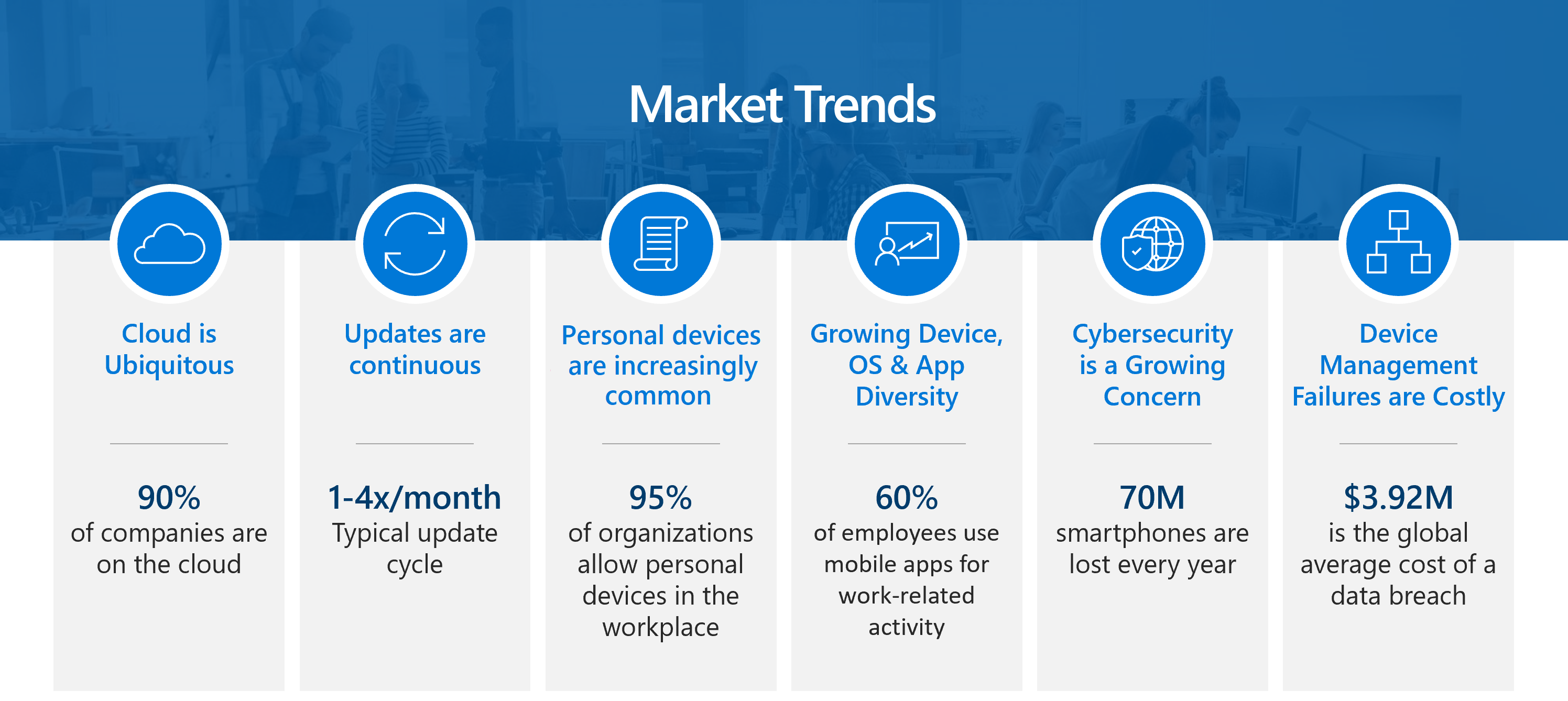Introduction
Technology is evolving in the modern workplace, as shown by the following diagram.

The diagram shows that:
- Most companies use cloud services.
- Software updates are continuous and frequent.
- Most companies allow use of personal mobile devices in the workplace.
- Most employees use mobile apps for work-related activities.
- Cybersecurity is a growing concern,
- Device management failures and data breaches are costly.
This workplace evolution leads to the following changes in information technology (IT) practices:
- Knowledge workers that used single devices now use multiple devices.
- Shared devices such as retail point of sale devices and ruggedized devices are more common.
- Specialized devices such as digital interactive whiteboards, conference room devices, and holographic wearable computers are more common.
- Devices that were corporate-owned can now belong to users or the corporation.
- Legacy apps on the corporate network are now joined by cloud-managed and software-as-a-service (SaaS) apps.
- IT admins are moving from manual, reactive processes toward automated, proactive processes.
- Instead of providing high-touch support environments, organizations now provide self-service solutions.
Access data
Users within your organization have the following characteristics:
- Can be employees, coworkers, or students.
- Might open and share personal files, visit unsecured websites, and install potentially unsafe apps.
- Want to use their devices to access all of their information and resources, whether at work, school, or home.
- Need to share information with trusted and verified coworkers.
To do their work, these users must be able to access organizational resources seamlessly and securely in the following ways:
- On iOS/iPadOS, Android, Windows, or macOS devices.
- On company devices or their own devices.
- On multiple types of devices.
- In various formats, such as from an app or displayed in a web browser.
As an IT admin or business decision maker, you must find modern methods and technologies to successfully protect your organization against digital threats while maintaining productivity. You can start by implementing services and tools to protect the digital devices, apps, and data, or endpoints, that the members of your organization need to be productive.
Protect resources
You can help protect resources and devices by using mobile device management (MDM) and mobile application management (MAM) services and tools.
- MAM enables organizations to manage and protect their data within applications.
- MDM enables organizations to protect and secure their resources and data based on enrolled devices.
By using MAM and MDM, organizations can ensure that only authorized people and devices get access to proprietary information. Device users can feel comfortable accessing work data from their devices, such as phones, because they know their devices meet their organization's security requirements.
MDM and MAM solutions must accomplish the following tasks:
- Make sure devices and apps are compliant with organizational security requirements.
- Use a single, unified mobile solution that enforces policies and helps manage devices, apps, users, and groups.
- Support a diverse mobile environment to securely manage iOS/iPadOS, Android, Windows, and macOS devices.
- Ensure that corporate services are easily available to users on all the devices they use.
- Protect company information by helping control the way the workforce accesses and shares its data.
- Create and distribute digital policies that help keep company data safe on organization-owned and personal devices.
- Ensure that users get a first-class support experience for the products they need to use, such as Office and Edge.
By implementing a management infrastructure, you can provide your users with IT services, apps, protection, and configuration to help them be more productive. For instance, users can automatically get their certificates, wireless network profiles, and virtual private network (VPN) settings without manually configuring them. Users are more productive because they don't have to do manual configuration, and are better protected because they have the correct settings.
You might know and already be using services and tools like Microsoft Intune, Microsoft Endpoint Configuration Manager, co-management, and Windows Autopilot. Microsoft Intune now combines all these services and tools. Intune is part of the Microsoft 365 stack of services that help protect your organization's endpoints by securing access, protecting data, and managing risk.
Learning objectives
In this module, you learn about:
- The products, services, and capabilities that make up Microsoft Intune.
- How Intune and Microsoft Configuration Manager can help protect your organization's endpoints.
- What Microsoft Intune can do for you and your organization.